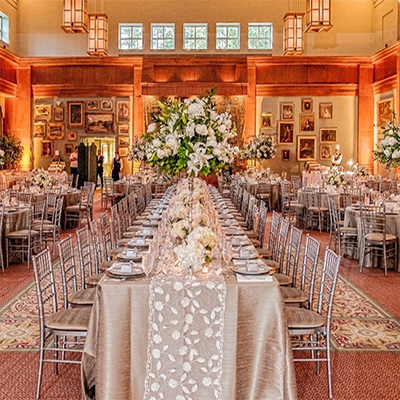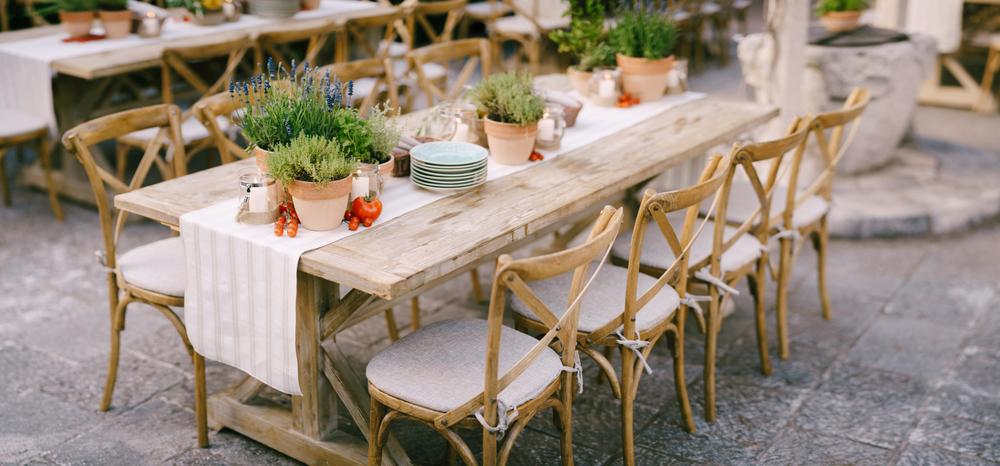Everything You Need To Know About Table Runners
A table runner is a long strip of fabric placed down the center of a table, typically used for decorative purposes. It is more narrow than a tablecloth and is usually used alongside the latter for extra decoration on a table setting.
When mapping out your home, restaurant, or event decor, you will soon learn that every little aspect counts. It is critical to ensure that your decor choices complement the overall theme. Therefore, table runners are not just a last-minute decision but an important consideration.
This post will explore the history, uses, and mishaps when using table runners and what to consider when choosing them.
Brief History of Table Runners
Table runners have been used for centuries as a decorative element on tables, adding color, texture, and style to a dining or banquet table. We can trace back the history of table runners to ancient civilizations.
In ancient Egypt, table runners were made of linen and decorated with hieroglyphics or geometric patterns. Here, people used table runners to protect the table from scratches and spills during meals. In ancient Greece and Rome, the people used table runners for a similar purpose, but they were often made of wool or silk and adorned with intricate patterns and designs.
During the Middle Ages, table runners became more elaborate and decorative, denoting the homeowner’s social status. Often, table runners were made of rich fabrics like velvet, silk, or brocade and embellished with gold or silver thread, embroidery, or applique. They were also used to display the owner’s valuable silverware collection and other tableware.
In the Renaissance, table runners became even more ornate, with elaborate designs that included floral motifs, animals, and mythological figures. They were often made of expensive fabrics and used during banquets and formal dinners.
During the 19th and early 20th centuries, table runners were popular decorative elements in the home. They were often made of lace or linen and embroidered with delicate floral designs or monograms. They were used for both everyday meals and formal occasions.

Table runners are still used in homes, restaurants, and events as a decorative element. They come in a wide range of materials, colors, and styles, from traditional to contemporary, and are often used to complement the room’s overall decor.
Uses Of Table Runners
Table runners can add an elegant touch to any table setting. Here are some uses of table runners –
- Centerpiece accent – Use a table runner as a backdrop for your centerpiece, making it the focal point of your table. This is particularly effective for rectangular or oval-shaped tables.
- Layering – Layer a table runner over a tablecloth to add depth and texture to your table. Choose a complementary color or pattern for a cohesive look.
- Color pop – Use a brightly colored table runner to add a pop of color to an otherwise neutral table setting. This can be particularly effective for outdoor events or casual gatherings.
- Contrasting textures – Pair a table runner made from a different material or texture with your tablecloth to add visual interest. For example, pair a silk table runner with a linen tablecloth.
- Long tables – Use table runners to break up long tables into smaller sections, creating a more intimate setting. This is particularly effective for weddings or large gatherings.
- Unique placements – Use a table runner to create unique guest placements. For example, place a table runner on the diagonal across each place setting, or use a table runner to create a circular or spiral placement.
- Buffet tables – Use a table runner to highlight different sections of your buffet table, making it easy for guests to find what they want. This is particularly effective for large events with multiple food stations.
There are numerous ways to incorporate table runners into your setup, and there’s no right or wrong way. The good news is that the choice depends on your unique style and preferences.
Common Table Runner Mishaps
Let’s look at some common mishaps associated with table runners, shall we?
- Size and length – If a table runner is too short or too long, it can look awkward and out of place on the table. Measure your table before purchasing a runner to ensure it fits properly.
- Material and texture – Different materials and textures can affect how a table runner lays on the table. If the material is too stiff or thin, it can create bumps and wrinkles on the surface, making your setup messy and untidy.
- Color and pattern – Choosing the wrong color or pattern for your table runner can clash with the rest of the table setting or decor. Make sure to consider the overall color scheme and theme of the occasion.
- Cleaning and maintenance – Some table runners require special care when it comes to cleaning and maintenance. Check the care instructions before purchasing to ensure it is something you can handle.
- Wrinkles and creases – Table runners can become wrinkled or creased during storage or transportation. Remember to iron or steam the runner before using it on the table to ensure it looks neat and presentable.
- Overcrowding – Placing too many items on top of a table runner can cause it to bunch up or shift, creating an unappealing look. Ensure enough space on the table for the runner to lay flat.
- Windy conditions – If using a table runner for an outdoor event, wind can cause it to blow around and become disheveled. Consider using weights or clips to keep it in place.
From the list above, it is clear that things could go wrong when we fail to give table runners care and attention. Therefore, you must partner with an event rental company that will deliver quality service. Curated Events is the top choice.
Things To Consider When Choosing Table Runners
Although there are no hard and fast rules when choosing table runners, there are several factors to consider:
- Table Size: The size of your table should be the first consideration when choosing a table runner. You want to ensure that the runner is long enough to cover the length of the table but not so long that it hangs over the edges and becomes a tripping hazard.
- Style and Color: Table runners come in various styles and colors. Consider the overall aesthetic of your room and the occasion for which you’ll be using the runner. If you’re looking for a runner for a formal dinner party, you should choose a more elegant and subdued runner. For a casual gathering, a brightly colored or patterned runner can be a fun addition to your table.
- Material: Table runners can be made from different materials, including cotton, linen, silk, and more. Consider the durability of the material and how easy it is to clean. If you’re looking for a runner that you will use frequently, choose a material that is easy to clean and maintain.
- Functionality: Consider the function of the table runner. Will it be purely decorative, or will it be functional as well? If you use the runner for a formal dinner party, choose a decorative runner. If you are using the runner for everyday meals, choose a more durable and functional runner.
- Cost: Table runners can vary in price, so consider your budget when choosing a runner. You can find runners at various prices, from inexpensive options to high-end designer runners. Choose a runner that fits within your budget and meets your needs.
It would be a great disservice to your entire setup if your table runners clashed with the theme or failed to complement the other decor elements. Curated Events can assist if you’re having trouble using table runners appropriately.
Bottom Line
Table runners have a rich history dating back to ancient civilizations and have become a staple in modern-day dining and event decor. They serve functional and aesthetic purposes, protecting the table while adding color and texture to the overall setting.
When choosing a table runner, it is vital to consider factors such as the occasion, the color scheme, the material, and the size. A neutral or subdued color palette may be appropriate for formal events, while brighter and more vibrant colors may be suitable for casual gatherings. The material of the runner should also be chosen carefully, with factors such as durability and maintenance in mind.
Ultimately, the choice of a table runner can significantly enhance the ambiance of any occasion. With careful consideration, choosing the appropriate table runner can transform a table into a beautiful and inviting setting that will leave a lasting impression on guests.
At Curated Events, we understand the significance of paying attention to every detail. Furthermore, we are well-equipped to handle all your event rental needs. Reach out to us today.

